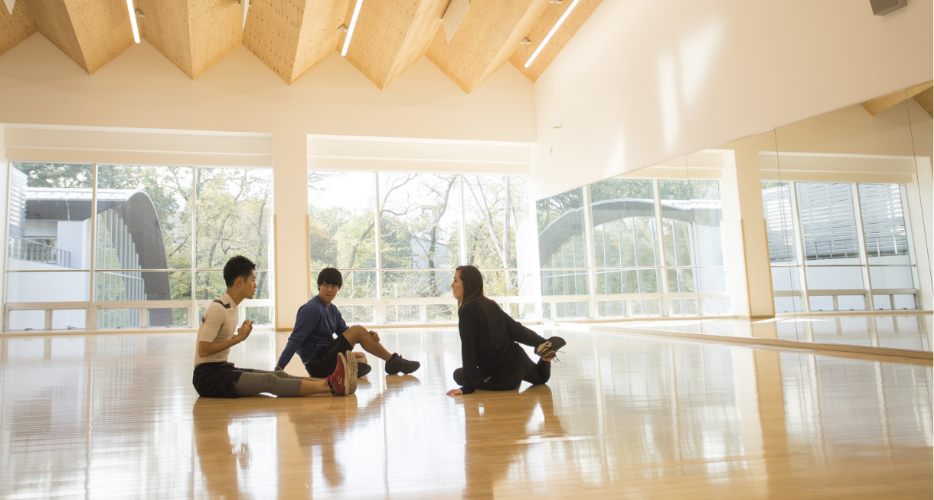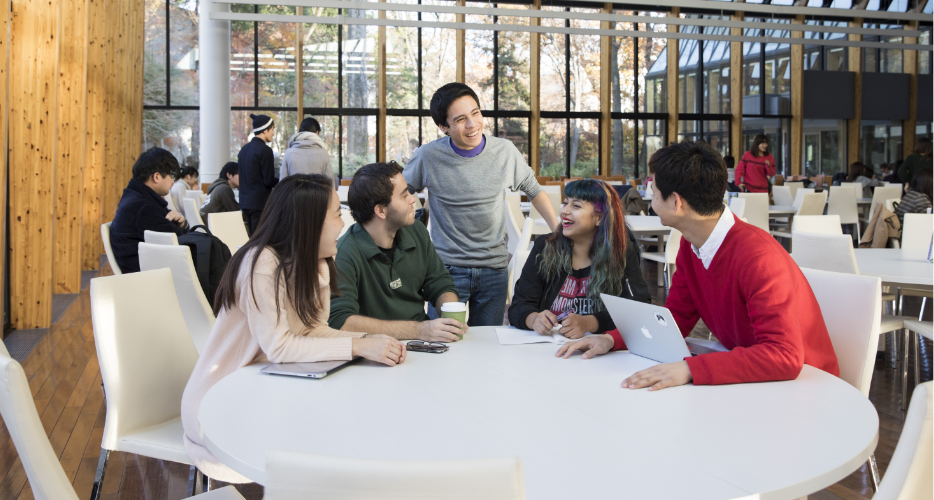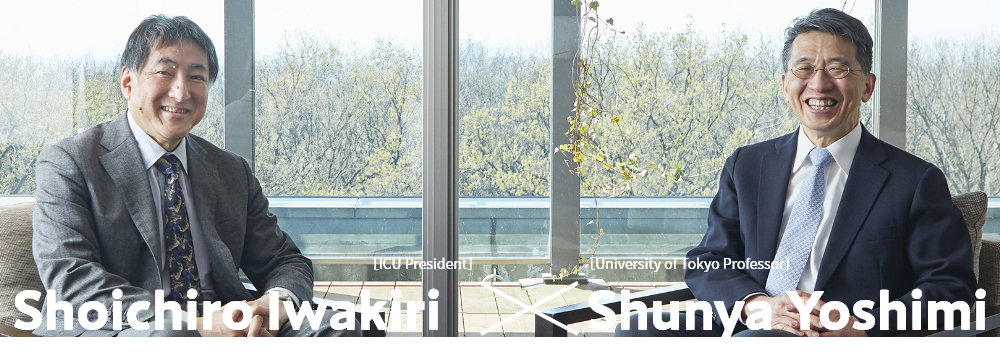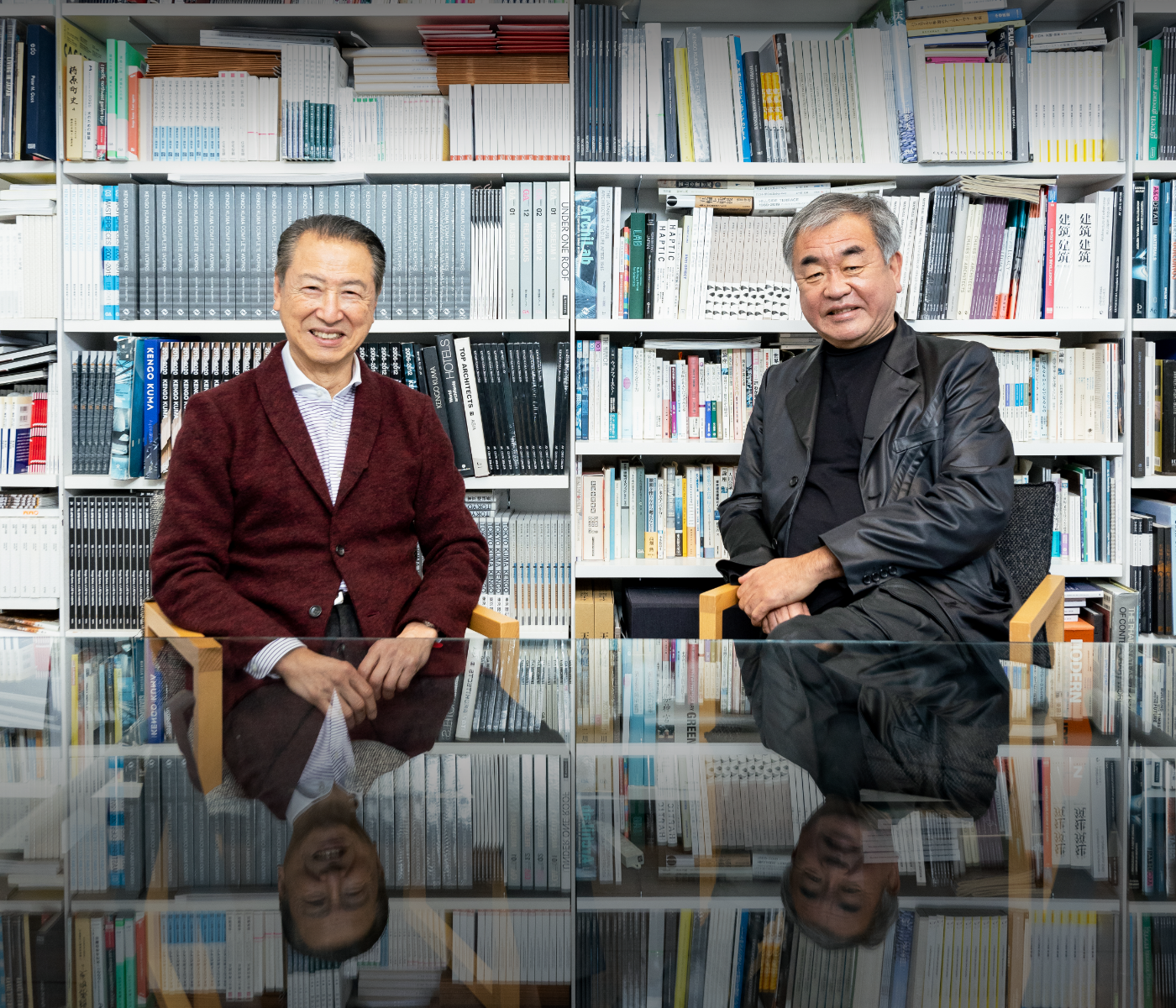
Renowned for designing numerous acclaimed buildings around the world, architect Kengo
Kuma is also involved in the ICU Campus Grand Design.
ICU Chair of the Board of Trustees, Hirotaka Takeuchi, visited him at his office in Aoyama.
Here is the dialogue between the master builder and business administration scholar.
#Memory of the community / #Back to nature from an urban environment /
#Japanese
aesthetics and culture / #Post-coronavirus
“The culture of the university is what matters in this era”
The shape of the
university community
The number of universities in Japan continues to grow, with higher education fast becoming the norm. As the 18-year-old population continues to shrink, universities vie for students in harsh competition with their rivals. Enticing students to choose a particular university will require offering distinct values.
Following a drastic change in the criteria by which students choose universities, the conventional hensachi (deviation score) metric will no longer suffice when making judgements about which universities to choose from. How do educational institutions stand the test of time in earning a place over others in this uphill battle?
Kuma provided a clue, saying, “Universities need a distinct culture to survive.
The campus plays an important role in passing on that culture.”
How do the architect, who has seen many cultures through his building projects around the world, and the Chair of the Board of Trustees, who spent his undergraduate years at ICU and now holds a professorship at Harvard
Business School, see the ICU culture and community?
They delved into the core of the ICU culture in relation to Kuma’s Campus Grand Design.
INDEX
- 01 Passing on the features of the community developed since the foundation of ICU to the next generation
- 02Harmony with nature in a bountiful learning environment
- 03The reality of the campus that surfaced with the pandemic
- 04The first step towards a worldwide presence: respect and take pride in Japanese culture
- 05Discerning what will remain and what will change with the pandemic
Paragraph 01
Passing on the features of the community developed since the foundation of ICU to the next generation
Currently ICU is maintaining and renovating the campus facilities based on the
Campus Grand Design. It is an extraordinary, long-term plan that looks ahead to the next 50 years. As a
place of learning, what will change at ICU, and what will remain? The two men engaged in a conversation that
revolved around the concepts of history and nature.
Kuma expressed his impression of the campus: “One of the distinguishing characteristics of the facilities at
ICU is that you have buildings designed by William Merrell Vories, a lay Christian missionary who was just
as passionate about evangelical activities as the design of the buildings on campus. For him,
construction of the facilities meant more than just business. They were structures imbued with his
spirit, shaping the DNA inherent in the original facilities at ICU and passed on to the present.”
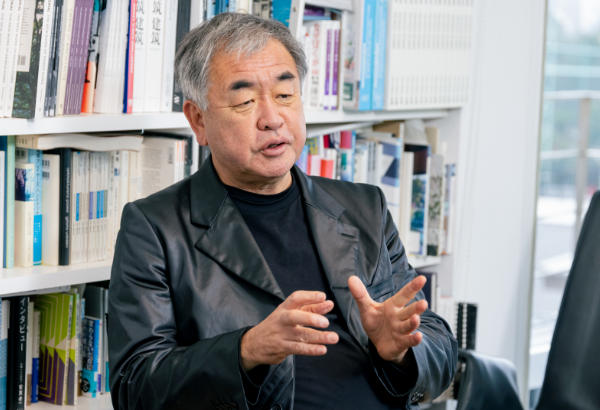
Takeuchi also talked about his memories of the Vories buildings on campus, especially Diffendorfer Memorial Hall (D-kan) East Wing. “I spent a lot of time in the D-kan talking with friends and faculty. We entered its doors, not just to study, but also to see plays and to attend jazz concerts performed in the auditorium. It was a place where friends and faculty from a wide range of backgrounds gathered for intellectual activity typical of the ICU community.”
After much discussion about the scope of rebuilding required for the D-kan East Wing due to deterioration and after reassessing the lifespan of the building, the university resolved to repair the interior. This was an important decision from the point of view of passing on the DNA of ICU.
Kuma elaborated on the meaning of preserving buildings with a history in the community. “Echoes of the past reverberate from them: students remember studying and growing there. The campus itself can have a powerful influence on those who dwell there, perhaps resonating more than text or visual images. That can be used to strengthen and sustain the bond within the community. ICU’s buildings and places of learning are directly linked with the nature of its community: as an architect, it’s most rewarding to be able to pass this culture on to the next generation.”
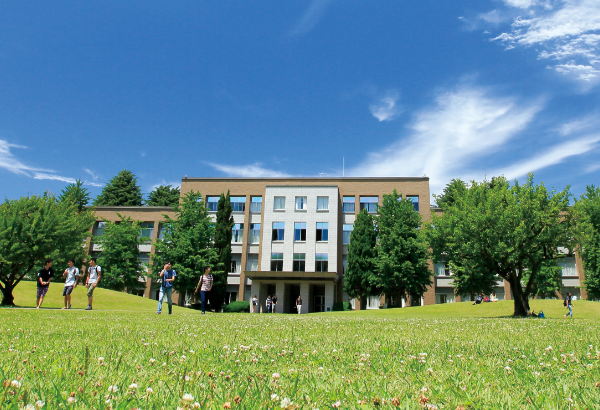
Takeuchi followed with a remark about the genesis of ICU: “The University was established with generous donations from Japan and the U.S. With deep regret for the tragedy wrought by World War II, Christians seeking peace and the common good set up the Japan ICU Foundation (JICUF)in the U.S. that led to a large-scale drive for donations to establish ICU. The community was built first and foremost on the idea of peace, which has been passed on to alumni of all generations. I’m so grateful you’ve taken in the culture of our community in working on the Campus Grand Design.”
This culture has been passed on from the W.M. Vories and Company Architects of the founding days to the renowned Raymond Architectural Design Office and Maekawa Kunio Associates. The history of the buildings has been inherited over the generations in conjunction with the liberal arts education and culture of ICU.
Paragraph 02
Harmony with nature in a bountiful learning environment
In addition to its history, another important element in the identity of ICU is its nature. The spacious wooded campus cultivates unrestrained dialogue with friends which supports the culture that helps students mature as human beings.
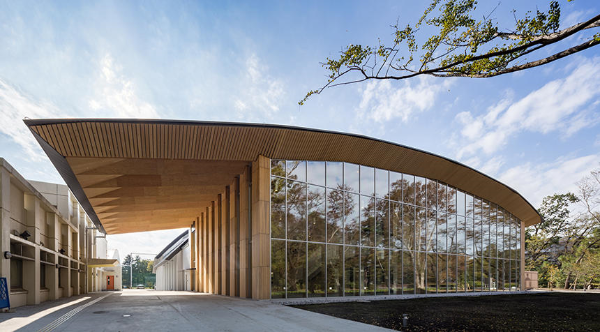
The Campus Grand Design takes a step further in blending the nature and buildings on campus. In the new Physical Education Center completed in 2018, for example, abundant woodwork proliferates in Kuma’s iconic design. He notes, “My first work with ICU was the design of the new Gymnasium. I was so impressed with the rich nature of the campus, I knew I would have to imbue the design with a distinct ICU feel, something very different from things I had done elsewhere. So I emphasized natural materials. The new Gymnasium has eaves that make it possible to enjoy the surrounding nature inside the building.”
Takeuchi replied, “I went to see the new Gymnasium right after I became Chair of the Board of Trustees. I was curious to see why NBA superstar Stephan Curry had singled out our gym (the only one he visited in Japan) for his basketball training camp in 8 cities around the world for high-school students: the key was harmony with nature.”
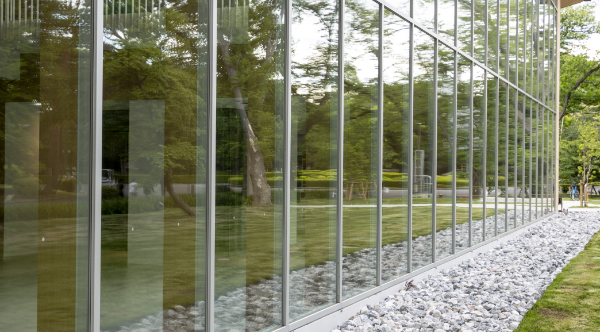
Blending architecture with nature has been an important theme for Kuma. The concept has gained renewed traction amidst the coronavirus pandemic with changes in perspectives for urban design. “I feel the pandemic has been a turning point for architecture. It used to be that filling buildings with more people was considered a sign of efficiency in the urbanization process. As we evolved from the hunting and gathering days, the inclination was to pack people into limited spaces, which must have been very stressful for humans. Reconsidering the need to disperse, rather than assemble, people by returning from the cities to nature means going back to square one in designing our buildings and thinking about how to make use of exterior space.”
In this era, we are deviating from packing people into box-like structures to expanding our sphere of being to the exterior. How should buildings on a university campus evolve to adapt to this paradigm shift?
Paragraph 03
The reality of the campus that surfaced with the pandemic
So what is the role of the campus for a university?
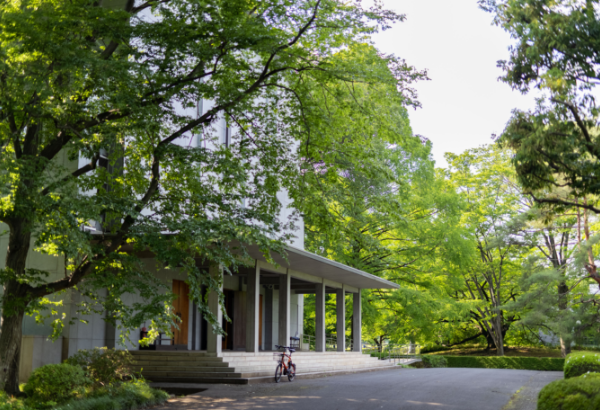
Contemporary university campuses have myriad types and forms, and such
diversity has only grown as a result of the COVID-19 pandemic. Some Japanese universities remain on the
site where they were founded, weaving their history into a legacy. Others have moved from central Tokyo
to the suburbs, seeking a larger campus following the era of rapid economic growth. Some have returned
to the city center in the form of high-rise buildings. ICU is a rare case with a campus full of nature
within metropolitan Tokyo.
Facilities also assume very different forms, such as a co-ed international dormitory or a learning
commons, following trends that incorporate the active learning approach.
Some universities also exist without a campus, such as the Minerva Schools at KGI founded in 2014, which was focusing on online instruction even before the pandemic. Here, students move from dorm to dorm in 7 cities around the world during their 4 years in college. In a sense the world is their campus and their community.
Then what is a campus for? The answer lies in what Kuma describes as a courtyard.
“There’s a long tradition of emphasizing the courtyard in differentiating a campus plan from other architectural design. The surrounding buildings and classrooms might undergo change with time, but the courtyard would remain a forum for students, where they engage in dialogue that enhances the bond within the community, and this is of crucial importance to cultivating the campus culture.”
The campus is clearly an important space in higher education for learning with
people such as faculty and peers, but objects and the environment can also be potent agents in the
learning process. This can be explained by the fact that many students expressed their desire to
come to the campus even during the pandemic.
The light that descends on the classroom, curtains fluttering with the wind, sunlight streaming through the
leaves on the boulevard, the clouds floating by―spending time with friends on campus stimulates dialogue,
inspires ideas, and creates new thoughts. Immersion in the verdant environment offers a setting for
incubating a distinct culture.
The role of the campus, then, is to offer a courtyard for learning. Even if a physical campus does not exist, or regardless of the kind of facilities and buildings on offer, a campus must appropriately serve as a venue befitting higher education where intellect and specialist knowledge are cultivated. The courtyard serves as the backbone of the university culture.
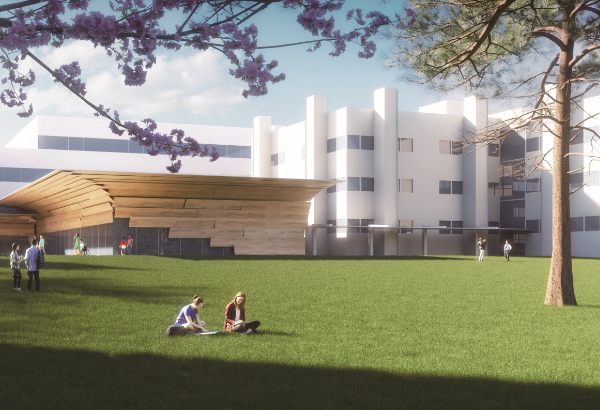
At ICU, a new Kuma building will be completed in 2022, the second of his works on campus. With its large eaves and cloisters, it will showcase the architect’s innovative approach in merging the interior and exterior.
But the new building will offer more to ICU than Kuma’s vision of harmony with nature. It will be an attempt to rebuild a courtyard for learning in the post-coronavirus era, a challenging experiment for ICU.
Paragraph 04
The first step towards a worldwide presence: respect and take pride in Japanese culture
When asked what was required to exercise an active presence on the global stage, Kuma, who has received numerous prestigious awards around the world, and Takeuchi, a professor at Harvard Business School, shared the belief that you need to respect and take pride in the Japanese aesthetic and culture.
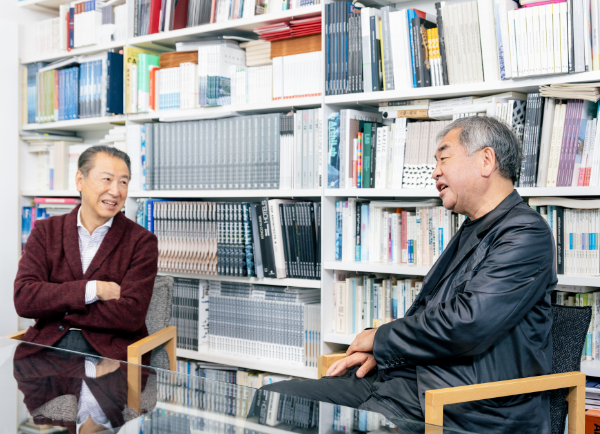
The aforementioned idea of incorporating the exterior as an element of the interior, has roots in Japanese architectural practices that foreign architects have noted and admired.
Kuma, a connoisseur of Japanese tradition using components and space from a different era, told us about his experience. “Most Japanese don’t notice how exceptional their own culture is when in Japan. I’m no exception. It wasn’t until I started living in New York that I noticed the beauty of my own culture. Those with a sharp sensitivity and interested in Japanese architecture bombarded me with questions. That was when I realized how attractive our architectural heritage was and started studying it.”
Kuma continued, “In view of the current global trends, I think the advantages of our culture will be realized in the context of symbiosis with the environment. Japanese culture has a lot to offer in solving environmental problems, so I would advise the younger generation to be proud of this fact and to be confident as they go out into the world.”
Takeuchi talked about the expansion of the concept of sustainability as described in the Sustainable Development Goals adopted at the United Nations Summit in September 2015.
“Japanese culture has always been very conscious of the concept of sustainability. In business management, some ideas in the Japanese tradition relate to stakeholder capitalism, which takes into account the needs of all stakeholders such as your business counterpart, society and employees. Many Japanese companies have for long been faithful to the mission, yonotame, hitonotame (for the benefit of society and other people) or the Ōmi merchants’ philosophy of sanpo-yoshi, which translates as three-way satisfaction, or simultaneous good for yourself, the consumer and the wider community. We don’t have to import everything. The first step to a global career is to realize that we have some very good ideas in our own culture.”
The Japanese have tended to regard foreign concepts as progressive and superior, without thinking critically about their merits. On this, the two men stressed the importance of critical thinking. They agreed that we should avoid accepting imported ideas unconditionally, and inspect them carefully. Takeuchi continued, “The advantage of studying at ICU is that the community is bilingual and multi-cultural.”
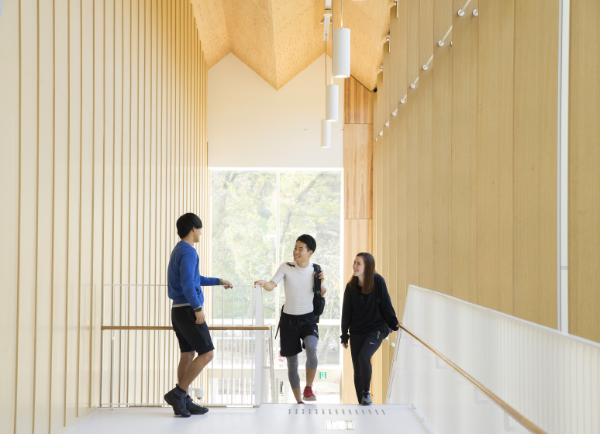
Students and faculty of diverse nationalities gather on the ICU campus. While constantly aware of their identity, they engage in exchange and dialogue with others. They are naturally inclined to reconsider what had been common sense in their own culture, in discerning the real value for themselves. ICU provides an optimum environment for what the two men emphasize as important-cultivating confidence in Japanese aesthetics and culture.
Paragraph 05
Discerning what will remain and what will change with the pandemic
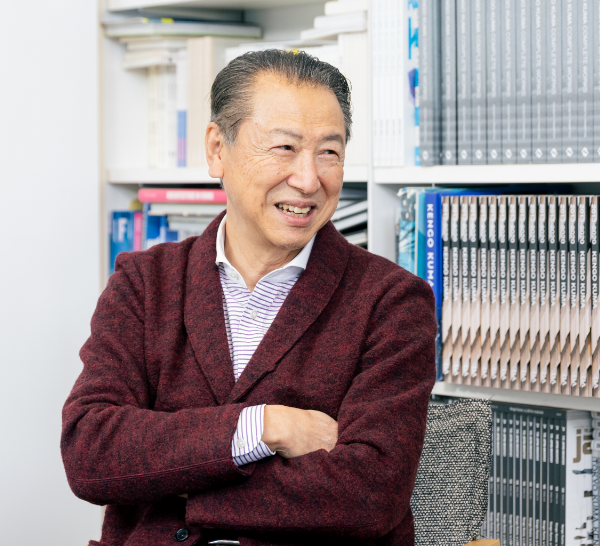
The pandemic has come to represent a turning point for architecture as well as for higher education. Online instruction has become the norm, with learning methods sure to diversify further in the post-coronavirus era.
But there is one thing that cannot be completely substituted with the online mode of instruction. That is dialogue, which is at the core of the learning process at ICU: education based on interaction.
Kuma, who has experience designing many educational institutions, said, “If
we’re talking about one-way communication, online works fine. But going forward, it will become more and
more important for people to meet in person, especially at universities.”
The large lawn area in front of the the University Hall has been a favorite place for students of all generations
to gather, enhancing dialogue and exchange. The Hub Central and Quadrangle (courtyard) in the new
building to be completed in 2022 is expected to promote further active dialogue on campus.
Kuma elaborated, “The interconnected atriums in the building will offer space for people to mingle. The classrooms that surround them may change with time, but the atrium will remain an important area to connect with others where students can feel they are an integral part of the ICU community.”
As an alumnus Takeuchi noted, “Many people ask me why I am back at ICU. My usual reply has been to return the favor from my alma mater. But, talking with you today, I realize that my mission is to pass on the baton of the culture cultivated at ICU to the next generation.”
The “culture” Takeuchi refers to here includes everything the ICU community stands for: harmony with nature, pride in Japanese aesthetics, and the high quality of the forum for learning. It will inspire, not only the next generation, but also serve as a model for higher education in Japan.
It is probably of no coincidence that this dialogue focused on the distinct culture of the ICU community as outlined in Dialogue on the Core Values of ICU #01. The coronavirus crisis posed a turning point for humankind and society; it also helped reveal the essence of ICU.
Japanese society and higher education institutions will be required to discern the bedrock values that remain amidst a sea of change and to develop them- as further trials await us.
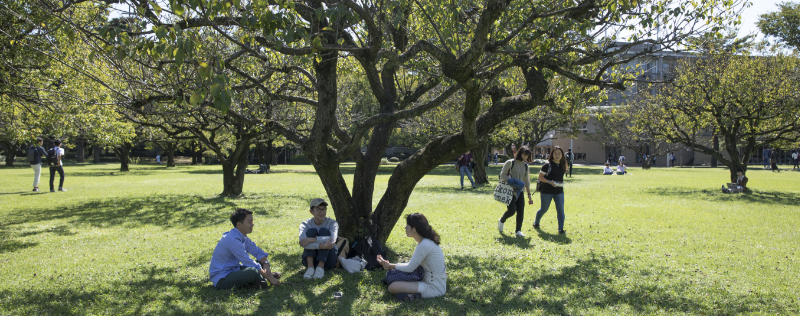
[Epilogue]
Buildings shape people.
These are words from W.M. Vories, a man whose spirit has definitely been inherited at ICU. Both Kuma and Takeuchi strongly believe that the campus environment cultivates students. The unique campus in harmony with nature will remain a key factor in the particular culture and community of ICU.
Kuma mentioned at the beginning of the conversation, “In this era, universities are judged for their culture. The campus is the most effective media the university possesses in conveying its identity. Some campuses today look like office buildings, but is that what students really need? I have great respect for the campus design that has been inherited from the founding days at ICU. It shows how firmly established the culture is here.”
The historical legacy and rich nature of the ICU campus will continue to be preserved. But that does not mean things will not change. The meaning of the campus has changed during the pandemic as in-person contact has assumed renewed value. It will be the mission of ICU, which continues to conduct educational experiments, to show, through the Campus Grand Design, a new educational model to other universities in Japan.
Related Information
Sub Dialogue
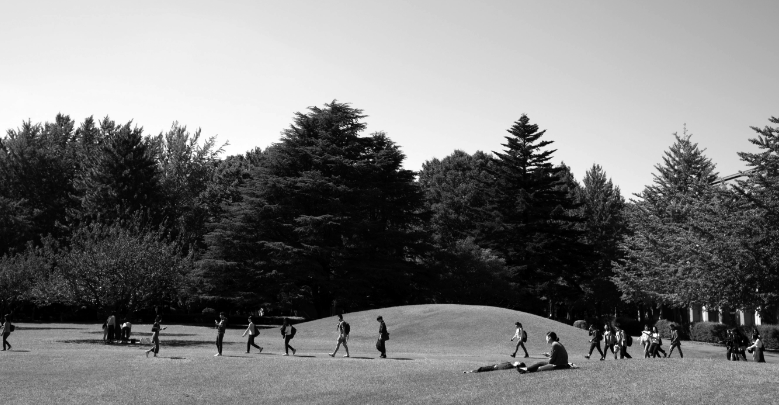
Intellectual interaction
Counterculture and the True, the Good and the Beautiful
The Mindset Kuma and Takeuchi Have in Common
A dialogue between two global figures engaging with the world
Acquaint yourself with the unfamiliar
Break away from the
hensachi mentality
- Kuma
- I wanted to become an architect after I saw Tange Kenzo’s Yoyogi National Gymnasium designed for the Tokyo Olympics in 1964. At the time, we were building lots of highways, bullet trains and buildings: mass production then was a good thing. But at the dawn of the 1970s, I witnessed environmental pollution and other problems, which made me think there was something wrong with the conventional mode of construction. I started questioning things that had seemed attractive. That’s when I learned to think critically.
- Takeuchi
- In my case, participating in the exchange program at UC Berkeley in 1968 was my first experience abroad where I realized the importance of observing things which were different.
- Kuma
- Student riots in their heyday?
- Takeuchi
- Yes. Student riots, flower children, hippies, those were protests against the establishment. Taking a dialectical approach, I’ve come to think that we always need discrepant ideas. It was a great opportunity to see and feel myriad ways of thinking in the U.S., away from Japan.
- Kuma
- It’s important to get to know people of different nationalities from a young age to understand diversity. It’s a pity that nowadays you don’t even see relatives very often, which can be an opportunity to mingle with different people.
- Takeuchi
- Some will be offended when I say this, but there may be something wrong with Japanese education or the way entrance examinations are implemented. People live in a closed environment, which limits their interest to hensachi. How can you judge a person by standard scores? The experience you just mentioned has to do with the study of the true, the good and the beautiful(shin, zen, bi). Pursuing universal truth will ultimately lead to liberal arts. We also need to reconsider the division between the sciences and arts. Being close to nature from a young age will also help. Kids shouldn’t spend time at prep schools. It’s more important for them to get outside, befriend nature and get muddy.
- Kuma
- I learned a lot from nature. I used to roam around the mountains and villages, where I discovered a lot. Living organisms are the ultimate other. They have their own rules and mechanisms that differ from ours. That’s what made me grow.
- Takeuchi
- Great advice! If you aspire to be like Kuma-sensei, go back to nature in the woodlands (laughter).
PROFILE

Hirotaka Takeuchi
The Chair of the ICU Board of Trustees graduated from ICU College of Liberal Arts in 1969. Specializing in business administration, he started teaching at Harvard Business School (HBS) in 1976. He became professor at Hitotsubashi University in 1987, and professor at HBS in 2010. He has served concurrently as Chair since June 2019.
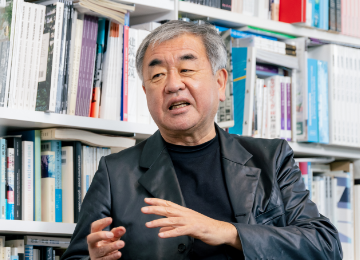
Kengo Kuma
The world-renowned architect founded Kengo Kuma and Associates (KKAA) in 1990. He has designed buildings in more than 20 countries and is the recipient of the Architectural Institute of Japan Education Award, the Spirit of Nature Wood Architecture Award (Finland) and the International Stone Architecture Award (Italy). He created the ICU Grand Campus Design.
Planning, and Production and Writing :WAVE.LTD




